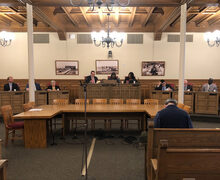Horn: Repurposing buildings provides way to revitalize Syracuse economy
Building on the foundations of past ideas, old and decrepit Syracuse structures are being recycled into new business prospects.
Long-abandoned, the West Brothers Knitting Co. factory in Syracuse will soon undergo a 15-month-long renovation process before reopening as an apartment block. The residence, which will be called Harbor Street Lofts, will contain 40 separate housing units and the building, once a victim of the industrial flight that Syracuse knows painfully well, will have a fresh face in the area.
The decision made by Edgemere Development Inc. and Sutton Real Estate Co. LLC to repurpose the former knitting factory is an excellent example of ways the city can work to get back on its feet, with private businesses profiting along the way. In any city, the use of space is of vital concern and if Syracuse is to succeed, it must continue to attract projects that aim to do so in a progressive fashion.
The benefit of the deal is clear for the community, considering 35 of the 40 apartments will be reserved for low-income families who will pay a reduced rent ranging from $575 to $750 a month, according to a statement earlier this month from Sutton. By comparison, the remaining five apartments will be sold at the market value range from $825 to $975 each month.
The fact that the companies are providing affordable living spaces could either be a conscious effort to give back or simply an avenue to decrease costs. The current apartment project is estimated to cost $11 million, but a small interest loan of $2.76 million — a part of a New York state initiative to create affordable housing — has driven down the financial burden.
However, considering Edgemere’s other projects include renovations of Syracuse’s Valley Vista apartment complex for elderly and disabled tenants, the companies’ plan seems to be a gesture that is both profitable to the community and the business.
John Yinger, a trustee professor of public administration and economics at Syracuse University’s Maxwell School of Citizenship and Public Affairs, explains that the problem is a difficult one for the city and state governments to tackle.
“All cities have to look for the best way to utilize their limited resources,” said Yinger. “Subsidizing is not necessarily the most efficient way to allocate money into alleviating poverty. Concentrated efforts, rather than independent projects, yield more results.”
He added that cities must focus their resources on aiding the people of their municipality with as little investment as possible because the city has other concerns and relief initiatives that are all competing for funding.
Despite the fact that the city’s other priorities could spur potential shortcomings, projects like these are vital to rebuilding Syracuse for numerous reasons. Creating stable and cost-effective housing for low-income families presents not only a reason for people to stay in Syracuse, but an attainable goal in improving their lives and living conditions. And by expanding low-cost housing in this way, it will be possible to bring people back from the suburbs and reduce the urban sprawl that lead to a host of problems for the city.
The concept of repurposing old spaces is certainly not new for Syracuse, and housing is not the only way that the city’s many abandoned buildings can and have been reintegrated into the community and the local economy.
We have seen the success of multiple ventures of this nature, including Armory Square, whose buildings remained in a similar forgotten state decades ago. Within the past year alone, there have been projects to renovate the historic Hotel Syracuse in addition to the Clinton Plaza apartments. Even SU cashed in on the renovation wave with the Nancy Cantor Warehouse, which has been occupied by the university for 10 years.
If Syracuse is looking for ways to expand, revitalize and transform its environment and local market, it must look no further than its many forsaken buildings. The city should bring people back to the city with low-income living places to break the cycle of gentrification. In this way, Syracuse can reuse existing spaces to creatively house entrepreneurial ventures, rather than authorizing the construction of an economically oppressive mall that continues to cast its shadow over its surroundings.
Syracuse is a city with plenty of potential, but it will only see success if it makes progress by constructively using its past as a base for the future.
Theo Horn is a sophomore political science and public policy dual major. His column appears weekly. He can be reached at tahorn@syr.edu.
Published on February 15, 2016 at 12:57 am






